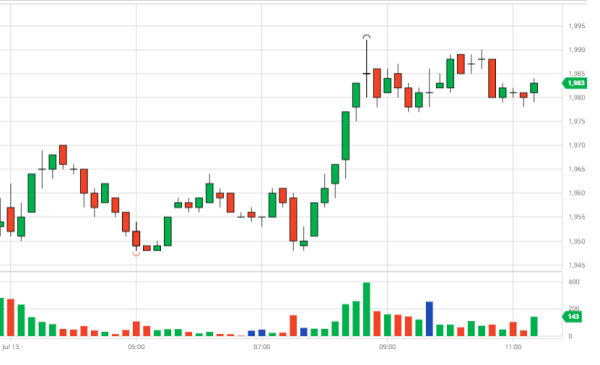The US CPI in June has brought optimism to the market, which will contribute to support for the FED to be stronger in adjusting the USD base interest rate to control inflation…

Robusta chart London September 2022 session on 13/07/2022
At the end of the session, the price of Robusta coffee on ICE Europe – London reversed to increase. The September spot term increased by $27 to $1,981/ton and the November delivery term increased by $28 to $1,979/ton, significant increases. Trading volume below average.
Similarly, the price of Arabica coffee on the ICE US floor – New York has the same upward trend. September spot futures rose 2.00 cents to 207.35 cents/lb and December futures rose 1.95 cents to 204.70 cents/lb, significant gains. Trading volume above average.
The price of green coffee beans in the Central Highlands provinces increased by 400-500 dong, up to range from 39,400 to 40,000 dong/kg.
The price of coffee futures reversed to increase when the reports of US economic indicators in the month were still somewhat optimistic, especially the CPI in June increased by 1.3% compared to the previous month, reaching 9.2. % (vs 8.6% forecast) has sparked speculation US Federal Reserve (Fed) will strongly raise the basic USD interest rate by 0.75-1.0% at the next two policy meeting on July 26 and 27, in order to fulfill the Fed’s commitment to controlling inflation. USD fell 0.64% to 1 USD = 5,4040 R$ helped coffee prices in the Brazilian domestic market regain the green as exporters increased purchases.
On the derivatives markets with high liquidity, the price of gold and crude oil continued to decline, giving way to the price of coffee, although the trading volume on the two futures exchanges was still not high due to investors. still standing outside to listen to macroeconomic news more fully. In particular, China’s export information continued to stagnate because of the outbreak of the disease, causing many provinces and cities to “close down” again.
Brazil’s weather has been favorable to promote the harvest and drying of new crop coffee. In the short term, only the full moon days of August in winter are still interested by speculators, while traders of the main consumer markets in the Northern Hemisphere are still on summer vacation. Therefore, trade in both futures markets is still not fully active.
English (giacaphe.com)
